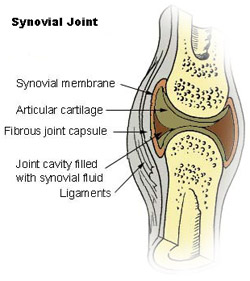Articulations
An articulation, or joint, is where two bones come together. In terms of the amount of movement they allow, there are three types of joints: immovable, slightly movable and freely movable.
Synarthroses
Synarthroses are immovable joints. The singular form is synarthrosis. In these joints, the bones come in very close contact and are separated only by a thin layer of fibrous connective tissue. The sutures in the skull are examples of immovable joints.
Amphiarthroses
Slightly movable joints are called amphiarthroses. The singular form is amphiarthrosis. In this type of joint, the bones are connected by hyaline cartilage or fibrocartilage. The ribs connected to the sternum by costal cartilages are slightly movable joints connected by hyaline cartilage. The symphysis pubis is a slightly movable joint in which there is a fibrocartilage pad between the two bones. The joints between the vertebrae and the intervertebral disks are also of this type.

Diarthroses
Most joints in the adult body are diarthroses, or freely movable joints. The singular form is diarthrosis. In this type of joint, the ends of the opposing bones are covered with hyaline cartilage, the articular cartilage, and they are separated by a space called the joint cavity. The components of the joints are enclosed in a dense fibrous joint capsule. The outer layer of the capsule consists of the ligaments that hold the bones together. The inner layer is the synovial membrane that secretes synovial fluid into the joint cavity for lubrication. Because all of these joints have a synovial membrane, they are sometimes called synovial joints.
